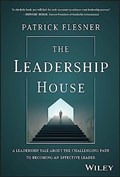- Leadership
A House for Leaders
Patrick Flesner’s engaging story reveals the essence of great leadership

Serial investor, Patrick Flesner, is an author who has learnt this lesson and now applied it to an unusual and stimulating new business book. In The Leadership House, he uses a personalized story to tease out and define the essentials of great leadership. Not that the story is without a framework for would-be great leaders to follow.
Embedded in his tale, the eponymous ‘House’ illustrates a framework with a foundation of TRUST, underpinning six vertical pillars: STRONG TEAM, SHARED GOALS, SHARED VALUES, JOINT PLANS, ACCOUNTABILITY, EMPOWERMENT, all supporting EXECUTION—a pitched roof pointed upward.
A leader only succeeds through the commitment of his or her followers. Understanding how to lead people, teams, or organizations effectively is the essence of good leadership. For people promoted into leadership roles—often without much prior training—knowing how to transform a diverse set of individuals into a cohesive unit able to drive an enterprise forward can be a daunting challenge. Many business books offer guidance—be agile, humble, empathetic, decisive, a servant, a mentor, a coach, etc.—but advice tends to be piecemeal and theoretical and hard to relate to or apply at the coalface.
Opening with the observation that “You are a leader because of the teams who want to be led by you,” Flesner’s story brings several leadership theories to life in a fun and highly relatable way. Without giving too much away, the plot involves a start-up business co-founder who has just been sacked as CEO by the venture capital owners. Following the dictum of Barack Obama, “The future belongs to those who press on," he perseveres, having first heard and accepted some unpalatable advice from a fellow CEO—a woman he meets in a lift—who points out where and why he has failed as a leader and how he might improve.
Bearing in mind that, according to a Stanford report, nine out of ten start-ups fail, our hero’s predicament is not unusual. What he learns is that poor leadership has been the fundamental cause of failure. He finds this very hard to accept but begins to see that he has fallen into the typical trap of being a victim, blaming others for failure, blaming the market, and being a rescuer who has stepped in to sort out his team’s shortcomings rather than helping them find the way themselves.
As the narrative unfolds, his poor leadership practices that have led to failure, become clear. With this the strength of the story format is evident. We truly feel our hero’s pain as we relate to the situations he has faced, understand the wrong paths he has taken, and recognize the better approach suggested by his new CEO mentor—the woman in the lift.
Her remedy revolves around the ‘House’ framework. Vision, and purpose are of course seen to be important, but the vision is not the foundation of great leadership, rather as she asserts “Vision is your North Star, high up in the sky above your Leadership House." The true foundation is trust and a leader’s first priority is to create a culture determined by trust, accountability, and collaboration. How this is done, the reasons it often is not done, and how to build the six pillars supporting execution, make up the core of this entertaining and memorable story.
……………………………………………………………………………………………………………
ARTICLES YOU MIGHT LIKE
BOOK REVIEW
Christopher Kayes explains how leaders can manage difficult emotions to lead outside their comfort zone
DEVELOPING LEADERS QUARTERLY MAGAZINE AND WEEKLY BRIEFING EMAILS

































